论文标题:Research on the Influencing Mechanism of Historic Urban Landscape Characteristics on Public Sentiments and the Spatio-temporal Differentiation Patterns—A Case Study of Shaoxing Ancient City in Zhejiang Province, China
期刊:Landscape Architecture Frontiers
作者:Tuo SHI, Wanchen SANG, Yunuo ZHENG
发表时间:15 Jun 2024
DOI:10.15302/J-LAF-1-020097
微信链接:点击此处阅读微信文章


注:本文为删减版,不可直接引用。原中英文全文刊发于《景观设计学》(Landscape Architecture Frontiers)2024年第12卷第3期。
导 读
本文提出了“历史性城市景观-认知-情绪”分析框架,从历史性城市景观(HUL)遗产本体价值、城市功能价值和城市景观价值三个维度,结合语义分析、时空立方体等方法,通过中国绍兴古城案例,揭示了历史性城市景观环境特征对公众情绪感知的影响机制及其时空异质性。研究发现,不同的HUL特征对公众情绪感知的影响具有异质性;同一HUL特征在不同的时间(工作日与节假日)和空间中,对公众情绪的影响也表现出不同的模式。在节假日,公众情绪感知更受到与遗产本体价值相关的特征的影响,而在工作日,由于公众活动的性质发生变化,城市功能价值类特征对公众情绪的影响更加显著,城市景观价值对公众情绪感知的正面影响也更为突出。本研究旨在为提升公众在城市空间中的感知和情绪体验、识别历史城市的潜在空间改善机会提供科学参考。
关键词
历史性城市景观;公众情绪感知;时空异质性;微博数据;时空立方体;“历史性城市景观-认知-情绪”分析框架
历史性城市景观特征对公众情绪感知的影响机制及时空异质性研究——以中国浙江省绍兴古城为例
Research on the Influencing Mechanism of Historic Urban Landscape Characteristics on Public Sentiments and the Spatio-temporal Differentiation Patterns—A Case Study of Shaoxing Ancient City in Zhejiang Province, China

浙江大学城乡规划设计研究院有限公司
01 引言
2011年,联合国教科文组织颁布了《关于历史性城市景观的建议书》,提出了“历史性城市景观”(HUL)的理念。古城作为HUL的一个重要子类,面临着全球化和现代化带来的各种挑战,其中,HUL的文化趋同和个性危机日益显著。
近年来,公众对空间环境的感知和情绪体验也逐渐成为城市研究的焦点,但将其与HUL相结合的探讨仍然较少。基于此,本研究提出“HUL-认知-情绪”的分析框架,特别关注历史城市HUL特征对公众情绪感知的影响机制,以期为提升公众幸福感、识别历史城市的潜在改善机会提供科学参考。
02 HUL视角下的公众情绪感知
在HUL视角下,人与所生活的地方能够产生深厚的情绪连接。随着位置服务技术的快速发展,可以通过感知设备和定位技术,基于时空单元对公众情绪感知进行可视化测度。社交媒体数据为公众情绪感知的测度和可视化提供了新的机会,有助于揭示公众情绪感知的时空分布特征。
HUL价值评价体系的准则层可以总结为“保护现状”“本体价值”和“城市结合度”三个方面。已有部分研究揭示了HUL本体价值如何影响公众对历史城市的感知,凸显了它在建立情绪连接和培养文化认同中的核心作用。然而,目前仍缺乏关于保护现状和城市结合度两个层面的公众情绪感知影响研究。
本研究将基于社交媒体大数据对公众情绪感知进行测度,旨在揭示HUL特征对公众情绪感知的具体影响机制,为在城市规划和管理中识别历史城市中的潜在改善空间并予以优化提供理论和实践支撑。
03 HUL-认知-情绪分析框架构建
本研究构建了“HUL-认知-情绪”(HCS)分析框架。该框架主要分为:HUL特征分析,公众情绪感知分析,以及公众情绪感知时空分布分析。综合这三个部分,HCS分析框架提供了一个可解释公众在HUL中的情绪感知产生过程的多维度视角。
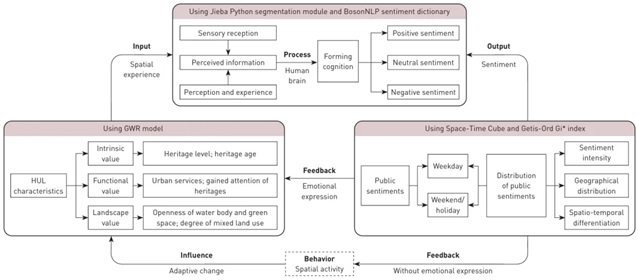
研究提出的HCS分析框架 © 石拓,桑万琛,郑预诺
04 研究区域与研究方法
研究区域
浙江省绍兴古城已有2500多年的建城史,其面积约9km2,古城包括八大历史文化街区,现有各级文物保护单位共62处;以20m×20m为网格单元构建空间分析网络。研究时段为2022年8月1日至2023年1月31日,对工作日和节假日进行差异化分析。
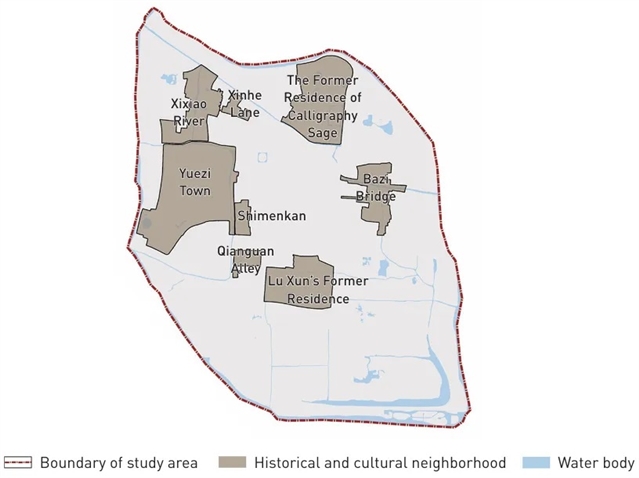
研究区域 © 石拓,桑万琛,郑预诺
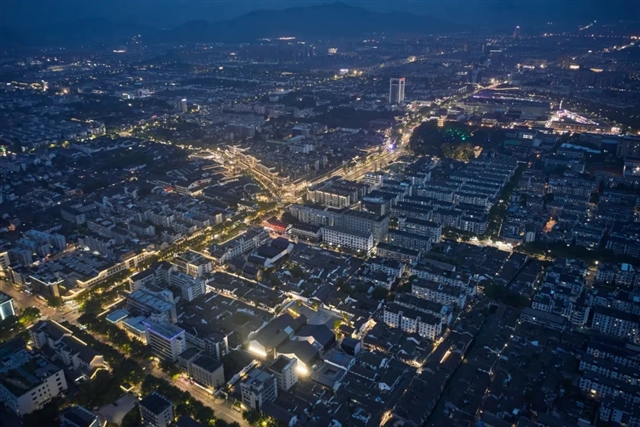
绍兴古城夜景航拍图 © 石拓,桑万琛,郑预诺
数据收集和处理
微博签到数据
微博签到数据指用户在微博平台上进行地理位置签到操作时产生的文本内容和时间信息等数据。研究采集了2022年8月1日至2023年1月31日研究区域内的微博签到数据;在剔除重复、空白、不相关内容和无关网页链接后,最终获得8151条有效签到数据。
HUL特征数据
HUL特征数据包括POI数据、历史遗产数据及遥感影像数据。POI数据主要涵盖休闲娱乐设施、交通设施和医疗服务设施,从高德地图上爬取。历史遗产数据包含研究区域内的文物保护单位的保护级别、建设年代和地理位置等信息,来源于《绍兴市历史文化名城保护规划(2021—2035年)》。研究从Google Earth采集了遥感数据,以识别研究区域内的土地覆盖类型与空间格局:借助ArcGIS Pro平台,将研究区域内的土地覆盖类型划分为绿地、水域、裸地、建筑、道路和不透水表面6个类别,然后在每个类别中随机选择20~30个验证点进行验证。
研究方法
研究使用Python对微博签到数据中的文本信息进行情绪分析。首先,进行文本信息分割,并统计每个词的出现频率;最后,采用情感词典来确定每条微博数据的情绪分数研究结合地理位置信息,选择反距离加权插值法对每条微博测度后的情绪分数进行空间插值,从而获得研究区域内的公众情绪感知分布。
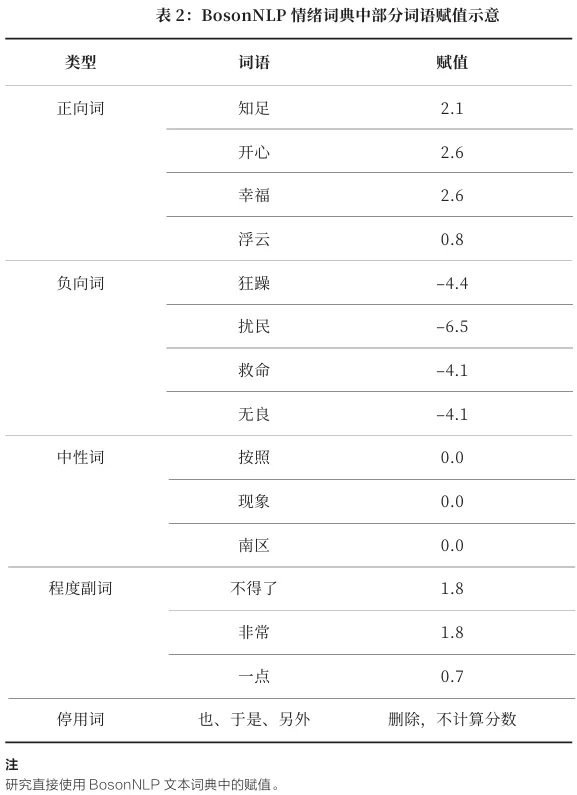
研究选择“时空立方体”的可视化方法来探究古城内公众情绪感知的时空分异特征。而后,研究选择Getis-Ord Gi*进行空间热点聚类分析,该指数能够反映某一区域内与周围区域的公众情绪感知程度之间的差异,从而识别出热点区域和冷点区域。

研究区域 © 石拓,桑万琛,郑预诺
研究使用GWR模型来分析绍兴古城HUL特征对公众情绪感知的影响机制。GWR模型可以有效解释回归系数的局部差异,以精确识别哪些HUL特征能够显著影响公众情绪感知。
05 绍兴古城公众情绪感知
时空异质性特征
分析结果显示,绍兴古城内的公众情绪感知分数的均值为6.983,公众情绪感知强度的均值为7.160。这表明公众整体情绪感知的积极性较高,且消极情绪在整体上并不占据主导地位,说明研究区域内的公众更倾向于积极的情绪体验。
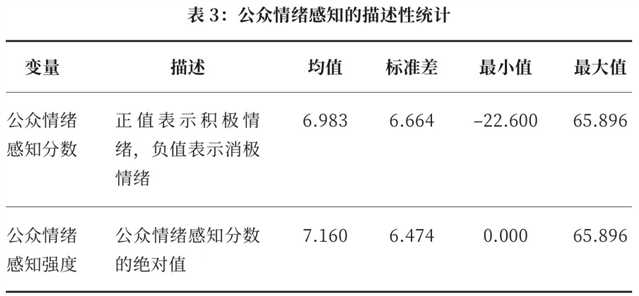
研究继而对公众微博发文数量和时间变化进行了详细分析,发现国庆节期间和春节前夕,微博发文量出现了明显高峰;而2022年12月底出现了显著的低谷,这与中国在该时期的疫情相关。同时,节假日的发文数量要显著高于工作日。
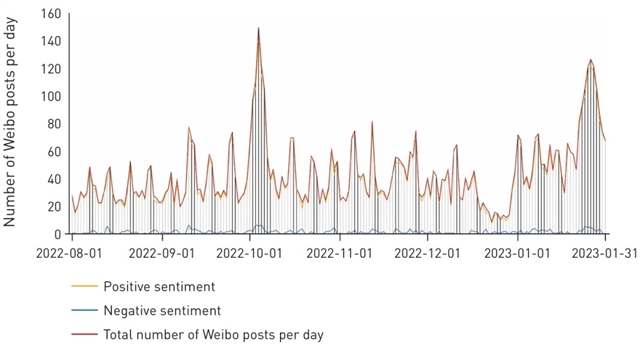
每日发文数量分析 © 石拓,桑万琛,郑预诺
研究发现,虽然在某些日期(如9月1日前后)消极情绪的强度超过了积极情绪,但当日的公众情绪感知分数均值仍然为正。造成此现象的原因可能是积极情绪的发文数量远超过消极情绪的发文数量。
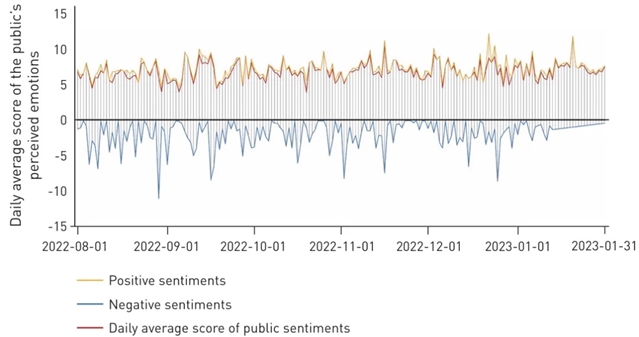
每日情绪分数均值分析 © 石拓,桑万琛,郑预诺
研究进而将每日的公众情绪感知分数均值进行可视化表达,结果表明,公众情绪感知呈现出显著的积聚性特征,且工作日和节假期的公众情绪感知呈现出明显的时空异质性。

工作日公众情绪感知的空间分布 © 石拓,桑万琛,郑预诺
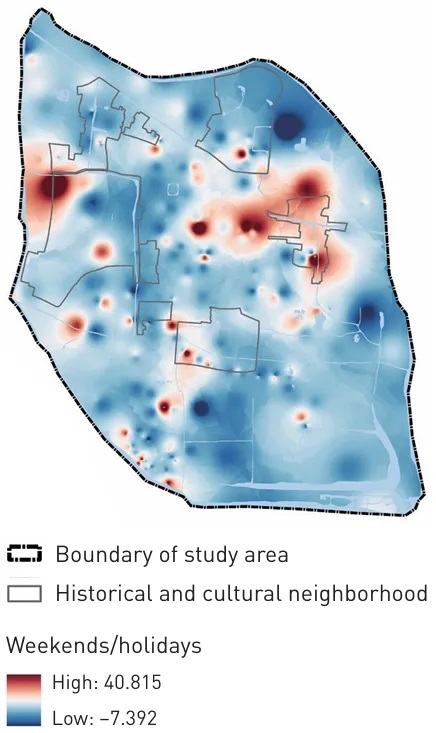
节假日公众情绪感知的空间分布 © 石拓,桑万琛,郑预诺
每日公众情绪感知时空立方体的冷热点分析结果显示,在2022年8~9月,高强度积极情绪积聚区首先出现在古城中部的前观巷街区。随着时间推移,在古城东北方向的八字桥和书圣故里街区也出现了明显的高强度积极情绪积聚。随着国庆假期的临近,鲁迅故里街区和东南部的沈园等重要历史文化遗产点附近出现高强度积极情绪积聚分布;10月1~10日,石门槛街区、西南部的金帝银泰城等位置同样呈现积极情绪积聚逐渐增多。11~12月期间,积极情绪的积聚逐渐减少,但仍然分布于石门槛、鲁迅故里、书圣故里街区,以及上大路古城入口等地。2023年1月上旬,积极情绪的积聚性明显抬升,以鲁迅故里街区最为明显,但整体仍以消极情绪为主。
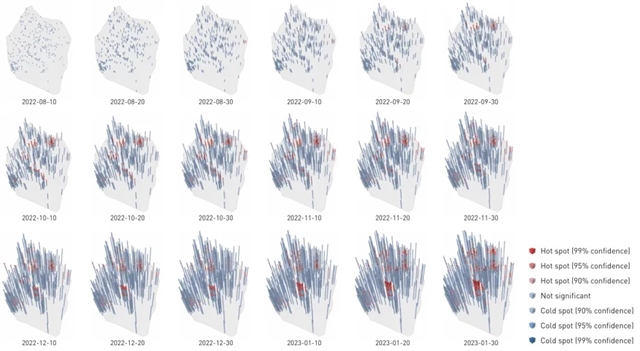
地块数量距离与直方图距离方法示意 © 周怀宇,向双斌
06 HUL特征对公众情绪感知的影响机制
影响因素的选取
研究从HUL遗产本体价值、城市功能价值和城市景观价值三个维度选取了共11个HUL特征变量作为解释变量。
1)遗产本体价值:选择遗产级别、遗产年代和山水价值作为评价指标。
2)城市功能价值:以建筑高度、打卡关注度、休闲娱乐设施密度、医疗服务设施密度及交通设施密度来评价HUL的功能价值。
3)城市景观价值:使用水域空间开敞度、绿地开敞度和土地利用混合度进行表征。
模型可信度分析
模型可信度分析和全局Moran’s I检验的基础上,研究构建了工作日和节假日的GWR模型,两个模型能够较好地解释公众情绪感知的影响变化。
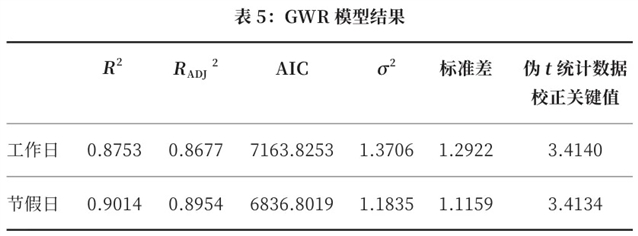
GWR结果分析
在遗产本体价值上,遗产级别和遗产年代与公众情绪感知分数呈现显著正相关性,这意味着较高级别、历史更悠久的遗产会对公众情绪感知产生积极影响。然而,山水价值在工作日中呈现负相关效应,可能是因为在日常工作压力下,人们可能会将自然美景的欣赏置于较低的优先级。
在城市功能价值上,与工作日相比,节假日休闲娱乐设施和医疗服务设施的影响,建筑高度和打卡关注度对公众情绪感知的负向影响也较弱,可能表明节假日人们对这些HUL特征关注度降低。
在城市景观价值上,水域空间开敞度和绿地开敞度在工作日和节假日对公众情绪感知的影响程度都较低。而土地利用混合度在工作日呈现正相关效应、在节假日中却呈现负相关效应。这表明,在节假日期间,人们可能更倾向于单一而直接的放松体验。
为了进一步探究各解释变量效应的空间异质性,研究选择在工作日和节假日对公众情绪感知影响都较显著的5个解释变量——遗产级别、遗产年代、山水价值、医疗服务设施密度和土地利用混合度——分别对各网格单元的回归系数进行可视化。
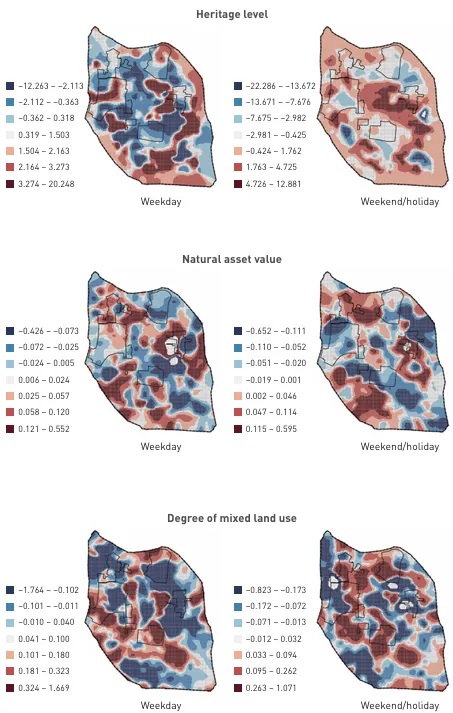
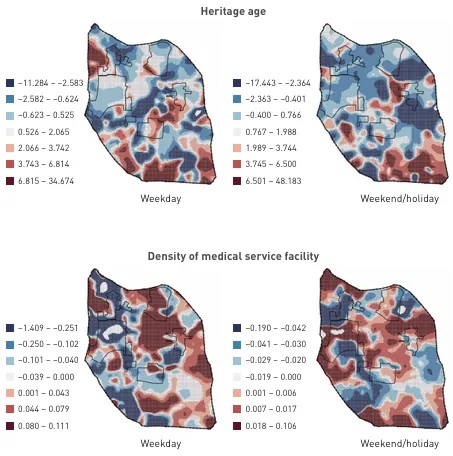
5个HUL特征对公众情绪感知影响的时空异质性 © 石拓,桑万琛,郑预诺
1)遗产级别:在工作日和节假日中,各有61.10%和52.14%的格网单元的遗产级别与公众情绪感知呈现正相关。工作日期间,正相关效应主要出现于居民日常居住和休闲的主要区域。在节假日期间,各街区和文物保护单位所在格网单元内出现的正相关效应显著增加。
2)遗产年代:在工作日和节假日中,各有60.85%和52.15%的格网单元的遗产年代与公众情绪感知呈现正相关。在工作日和节假日期间,正相关效应主要集中于八字桥街区和研究区域南部的部分地段,这些地区拥有跨多个历史时期的各种文化遗产。
3)山水价值:在工作日和节假日,各有58.56%和41.99%的格网单元具有正回归系数。在工作日,江南水乡和山川的特色景观,对公众情绪感知呈现明显正相关效应。然而,节假日期间,塔山等区域的山川景观对公众情绪感知呈现负相关效应,这与节假日期间旅游人流量增多、景观体验受限有关。
4)医疗服务设施密度:在工作日和节假日GWR模型中,各有37.45%和51.45%的空间单元具有正回归系数。整体上,医疗服务设施密度与公众情绪感知呈现显著的负相关效应,但本地居住区,呈现正相关效应。这表明对于居住区比较集中的区域来说,医疗服务设施的合理分布能够提高居民的积极情绪。
5)土地利用混合度:在工作日和节假日GWR模型中,各有58.90%和51.69%的空间单元具有正回归系数。这说明对于节假日的公众来说,多功能的历史文化场所能够有效提高积极情绪。
07 结论与讨论
HUL作为城市的文化遗产和历史记忆的集中体现,可以激发公众的情绪共鸣和认同感,从而提高公众的幸福感和满意度。本研究提出了“HUL-认知-情绪”分析框架,并从HUL遗产本体价值、城市功能价值和城市景观价值三个维度,对绍兴古城内公众情绪感知时空特征,以及HUL特征对公众情绪感知的影响机制进行了综合分析。结果表明,不同的HUL特征对公众情绪感知的影响具有异质性。需要注意的是,HUL特征对公众情绪感知的影响并非是一成不变的,城市设计者应结合公众情绪感知影响效应的局部特征,提出更有针对性的建成环境规划和政策。
尽管本研究对HUL特征与公众情绪感知的关系进行了初步探索,但仍存在一定局限性。首先,在社交媒体平台上主动发布信息的用户,可能更倾向于表达极端或强烈的情绪状态,这种倾向可能致使本研究采用的情绪感知可能与公众在实际HUL游览体验存在一定差异。其次,本研究选择遗产本体价值、城市功能价值和城市景观价值等来表征HUL特征,难以全面表征HUL的复杂性和多样性。此外,本研究的影响分析结果仅限于绍兴古城这一特定地区,未来研究可拓展研究范围和方法。
参考文献
[1] UNESCO. (2019). The UNESCO recommendation on the Historic Urban Landscape.
[2] Li, H., & Yang, L. (2019). Research on the management tools of Historic Urban Landscape—Historic townscape characterisation. Chinese Landscape Architecture, 35(5), 54–58.
[3] Lazarus, R. S. (1982). Thoughts on the relations between emotion and cognition. American Psychologist, 37(9), 1019–1024.
[4] Li, Y., Chen, X., Liu, P., & Huang, G. (2021). Research on image perception of heritage tourist destinations from the three-dimensional perspective of “cognition–emotion–integrity”: Taking Xiangjiang ancient town group as an example. Human Geography, 36(5), 167–176.
[5] Taylor, K. (2023). Historic Urban Landscape paradigm—A tool for balancing values and changes in the urban conservation process. Landscape Architecture Frontiers, 11(3), 96–104.
[6] Zhang, S., & Zhen, X. (2017). From historical features preservation to urban landscape management—Based on the Historic Urban Landscape approach. Landscape Architecture, (6), 14–21.
[7] Zhou, X., Sun, Z., & Liu, X. (2022). Research on the spatial perception and recreational experience of Historic Urban Landscape supported by the technology of digital footprint. New Architecture, (1), 10–15.
[8] Li, H., Li, M., Zou, H., Zhang, Y., & Cao, J. (2023). Urban sensory map: How do tourists “sense” a destination spatially?. Tourism Management, (97), 104723.
[9] Zhou, X., Liu, Z., & Shi, J. (2022). Evaluation on visual landscape perception under the support of digital footprint: A case study of Historic Urban Landscape of the Qinhuai River area. Landscape Architecture, 29(9), 18–25.
[10] Ginzarly, M., Roders, A. P., & Teller, J. (2019). Mapping historic urban landscape values through social media. Journal of Cultural Heritage, (36), 1–11.
[11] Dai, J., Huang, X., Sun, J., An, H., & Guo, Q. (2023). Research on the formation mechanism of tourist cultural identity in National Cultural Park—Taking the iconic natural landscapes of the Yellow River National Cultural Park as an example. Tourism Tribune, 38(1), 31–41.
[12] Taylor, K. (2008, September 29–October 4). Landscape and memory: Cultural landscapes, intangible values and some thoughts on Asia [Conference or Workshop Item]. 16th ICOMOS General Assembly and International Symposium: ‘Finding the Spirit of Place—between the Tangible and the Intangible’. Quebec, Canada.
[13] Liu, T., Butler, R. J., & Zhang, C. (2019). Evaluation of public perceptions of authenticity of urban heritage under the conservation paradigm of Historic Urban Landscape—A case study of the Five Avenues Historic District in Tianjin, China. Journal of Architectural Conservation, 25(3), 228–251.
[14] Hoteit, A. (2015). Role of the landscape in the preservation of collective memory and the enhancement of national belonging. Canadian Social Science, 11(3), 1–8.
[15] Bonadei, R., Cisani, M., & Viani, E. (2017). City walls as Historic Urban Landscape: A case study on participatory education. Journal of Tourism, Culture and Territorial Development, 8(7), 75–88.
[16] Anderson, K., & Smith, S. (2001). Editorial: Emotional geographies. Transactions of the Institute of British Geographers, 26(1), 7–10.
[17] Zhu, H., & Gao, Q. (2015). Review on “emotional turn” and emotional geographies in recent western geography. Geographical Research, 34(7), 1394–1406.
[18] Yang, L., Duarte, C. M., & Ciriquián, P. M. (2022). Quantifying the relationship between public sentiment and urban environment in Barcelona. Cities, (130), 103977.
[19] Lazarus, R. S. (1991). Emotion and Adaptation. Oxford University Press.
[20] Zhang, X. (2019). Emotion recognition via passive sensing [Doctoral dissertation]. Nanjing University.
[21] Li, Y., Gao, X., Yang, L., & Guo, J. (2020). Research on walking environment satisfaction of residents based on ordered probit model—A case study of Gulangyu. Chinese Landscape Architecture, 36(11), 90–94.
[22] Kerr, M. L., Rasmussen, H. F., Smiley, P. A., Buttitta, K. V., & Borelli, J. L. (2021). The development of toddlers’ emotion regulation within the family system: Associations with observed parent-child synchrony and interparental relationship satisfaction. Early Childhood Research Quarterly, (57), 215–227.
[23] Benita, F., Bansal, G., & Tunçer, B. (2019). Public spaces and happiness: Evidence from a large-scale field experiment. Health & Place, (56), 9–18.
[24] Rodríguez-Ibánez, M., Casánez-Ventura, A., Castejón-Mateos, F., & Cuenca-Jiménez, P.-M. (2023). A review on sentiment analysis from social media platforms. Expert Systems with Applications, (223), 119862.
[25] Mitchell, L., Frank, M. R., Harris, K. D., Dodds, P. S., & Danforth, C. M. (2013). The geography of happiness: Connecting Twitter sentiment and expression, demographics, and objective characteristics of place. PLoS One, 8(5), e64417.
[26] Shan, Z., An, Y., Yuan, M., & Huang, Y. (2022). Study on spatial and temporal distribution characteristics and influencing factors of urban residents’ sentiment based on Weibo data: A case study of the main urban area of Wuhan. Urban Development Studies, 29(8), 69–76.
[27] Kong, L., Liu, Z., Pan, X., Wang, Y., Guo, X., & Wu, J. (2022). How do different types and landscape attributes of urban parks affect visitors’ positive emotions?. Landscape and Urban Planning, (226), 104482.
[28] Wang, Y., Chew, A. W. Z., & Zhang, L. (2022). Deep learning modeling of public’s sentiments towards temporal evolution of COVID-19 transmission. Applied Soft Computing, (131), 109728.
[29] Amarasinghe, A. (2023). Public sentiment in times of terror. Journal of Development Economics, (162), 103058.
[30] Ginzarly, M., Houbart, C., & Teller, J. (2019). The Historic Urban Landscape approach to urban management: A systematic review. International Journal of Heritage Studies, 25(10), 999–1019.
[31] Jian, J., Zhen, F., Xi, G., & Zhai, Q. (2016). A review on emotional geography: Its progress and enlightenment. World Regional Studies, 25(2), 123–136.
[32] Lei, Z., Luo, J., & Cao, L. (2021). Quantitative research on historic city landscape value assessment based on AHP-GIS—Taking Taiyuan, a historic and cultural city, as an example. Journal of Taiyuan University of Technology, 52(4), 630–637.
[33] Shoval, N., Schvimer, Y., & Tamir, M. (2018). Tracking technologies and urban analysis: Adding the emotional dimension. Cities, (72), 34–42.
[34] Oren, G., Shani, A., & Poria, Y. (2021). Dialectical emotions in a dark heritage site: A study at the Auschwitz Death Camp. Tourism Management, (82), 104194.
[35] Jimura, T. (2011). The impact of world heritage site designation on local communities—A case study of Ogimachi, Shirakawa–mura, Japan,. Tourism Management, 32(2), 288–296.
[36] Su, M., & Wall, G. (2010). Place attachment and heritage tourism at the Great Wall. Journal of China Tourism Research, 6(4), 396–409.
[37] Medina-Viruel, M. J., López-Guzmán, T., Gálvez, J. C. P., & Jara-Alba, C. (2019). Emotional perception and tourist satisfaction in world heritage cities: The Renaissance monumental site of Úbeda and Baeza, Spain. Journal of Outdoor Recreation and Tourism, (27), 100226.
[38] Liang, J., Jiang, S., & Tao, L. (2020). Empirical research on the relationship between spatial-temporal behavior and emotion of tourists based on semantic analysis of online travel blogs and GIS visualization: A case of Beijing. Human Geography, 35(2), 152–160.
[39] Shaoxing Wuhan Municipal Bureau of Natural Resources and Planning. (2023, October 23). Public notice of draft of Shaoxing historical and cultural city protection plan (2021–2035).
[40] Zhu, Y., & Jing, J. (2019). Chinese word segmentation technology based on Python language. Communications Technology, 52(7), 1612–1619.
[41] Wang, Y., Chi, Y., Xu, J.-H., & Yuan, Y. (2022). Consumers’ attitudes and their effects on electric vehicle sales and charging infrastructure construction: An empirical study in China. Energy Policy, (165), 112983.
[42] Wan, P., Qiu, F., Xiang, F., Wang, J., Pan, C., Zhu, X., & Xu, L. (2022). Study on the Spatio-temporal Variation and Prediction Model of PM2.5 in Kunming. Environmental Science Survey, 41(2), 47–51, 56.
[43] Wang, H., Chen, R., Wei, S., Gui, L., & Fei, T. (2020). Mining emotional geography features based on Chinese Weibo data. Geomatics and Information Science of Wuhan University, 45(5), 699–708.
[44] Zhang, Q., Xu, D., & Ding, Y. (2021). Spatio-temporal pattern mining of the last 40 years of drought in China based on SPEI index and spatio-temporal cube. Agricultural Research in the Arid Areas, 39(3), 194–201.
[45] Xue, M., Wang, C., Zhao, J., & Li, M. (2020). Spatial differentiation pattern and influencing factors of tourism economy in the Yellow River Basin. Economic Geography, 40(4), 19–27.
[46] Tao, J., Dong, P., Zhou, N., Lu, Y., Gong, X., & Ma, X. (2022). Study on spatial distribution characteristics and influencing factors of historical and cultural towns and villages in the Yangtze River Economic Belt. Geography and Geo-Information Science, 38(3), 66–73.
[47] Wang, C., Wang, B., Wang, Q., & Lei, Y. (2023). Nonlinear associations between urban vitality and built environment factors and threshold effects: A case study of central Guangzhou City. Progress in Geography, 42(1),79–88.
[48] Ta, N., Zeng, Y., Zhu, Q., & Wu, J. (2020). Relationship between built environment and urban vitality in Shanghai downtown area based on big data. Scientia Geographica Sinica, 40(1), 60–68.
[49] Zhu, J., Fan, Y., & Fan, F. (2018). Factors affecting commute happiness of residents in big cities: A case study of Xi’an, China. Urban & Rural Planning, (3), 43–53.
[50] Fan, R., Zhao, J., Chen, Y., & Xu, K. (2014). Anger is more influential than joy: Sentiment correlation in Weibo. PLoS ONE, 9(10), e110184.
本文引用格式 / PLEASE CITE THIS ARTICLE AS
Shi, T., Sang, W., & Zheng, Y. (2024). Research on the influencing mechanism of Historic Urban Landscape characteristics on public sentiments and the spatio-temporal differentiation patterns—A case study of Shaoxing ancient city in Zhejiang Province. Landscape Architecture Frontiers, 12(3), 73–88. https://doi.org/10.15302/J-LAF-1-020097.
阅读原文请点击“Research on the Influencing Mechanism of Historic Urban Landscape Characteristics on Public Sentiments and the Spatio-temporal Differentiation Patterns—A Case Study of Shaoxing Ancient City in Zhejiang Province, China

《前沿》系列英文学术期刊
由教育部主管、高等教育出版社主办的《前沿》(Frontiers)系列英文学术期刊,于2006年正式创刊,以网络版和印刷版向全球发行。系列期刊包括基础科学、生命科学、工程技术和人文社会科学四个主题,是我国覆盖学科最广泛的英文学术期刊群,其中12种被SCI收录,其他也被A&HCI、Ei、MEDLINE或相应学科国际权威检索系统收录,具有一定的国际学术影响力。系列期刊采用在线优先出版方式,保证文章以最快速度发表。
中国学术前沿期刊网
http://journal.hep.com.cn

特别声明:本文转载仅仅是出于传播信息的需要,并不意味着代表本网站观点或证实其内容的真实性;如其他媒体、网站或个人从本网站转载使用,须保留本网站注明的“来源”,并自负版权等法律责任;作者如果不希望被转载或者联系转载稿费等事宜,请与我们接洽。